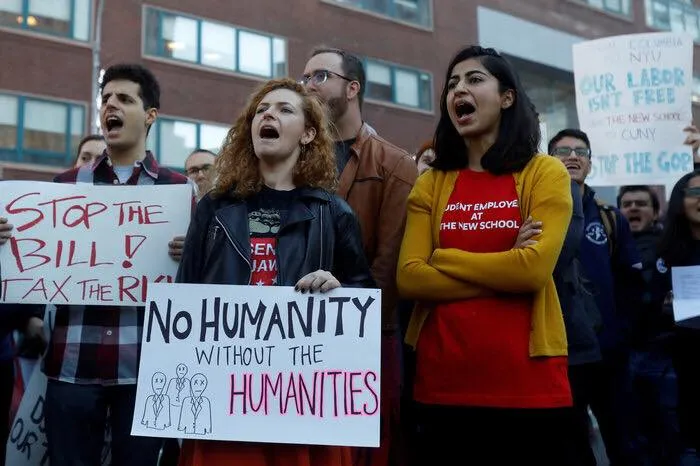Table of Contents
The recent corporate tax rate reduction may have been the most widely covered of the Republican tax reforms, but for most 20-year-old students the tax bill’s implications for higher education are paramount. After attacking the original House tax bill in a Faculty Senate meeting, President Marc Tessier-Lavigne furthered his own partisan take of the final bill in a Notes from the Quad post with Provost Persis Drell. During that Senate address, he described the bill as not “grounded in sound policy rationales.”
Are the school leaders correct to say that the new 1.4 percent endowment tax will extinguish “immeasurable benefits to the economy, health and culture of our country?” Would a tuition waiver tax or repeal of the student loan interest deduction have a harmful effect on “research and education that are so crucial to our country’s future?”
In an earlier article for the Review, Sam Wolfe wrote at length about the need to tax Stanford’s hedge fund–like endowment. In short, modern endowments now exemplify an investment strategy in which a portfolio is comprised of other investment funds. Typically, this results in dozens of heavily paid managers and high fees. By not taxing endowment gains, the government has been effectively subsidizing their profits. Given that other investors, even private charities, do not receive this special treatment, it’s fair to wonder why Stanford should be treated differently.
Tessier-Lavigne and Drell argue “the endowment at Stanford provides essential support for our core academic mission, including research, education, and financial aid.” However, even if research and scholarships are a public good, taxpayers should subsidize them directly through the legislative process, like Pell Grants, as opposed to using tricks in the tax code to subsidize a hedge fund in the hope that most of its profits go towards these venerable programs. Subsidizing the fund puts taxpayers on the hook for bloated administrative bureaucracies, high salaries for endowment managers, and other spending tangential to academic missions. See the juxtaposition between Louisiana State University’s new $85 million lazy river and its nearly 60-year-old, dilapidated library.
As for the tax on tuition waivers and repeal of the student loan interest deduction, students should feel resentful, not relieved, that those provisions were not included in the law. The student loan interest deduction was created as part of the Taxpayer Relief Act of 1997, long before federal policies guaranteed affordable payments for low income student loan borrowers by linking repayment plans to income level. Repealing the student loan interest deduction would therefore leave low income workers with manageable interest payments but also empower market forces to encourage thrift among students from higher socioeconomic backgrounds. In turn, colleges would be pressured to control costs and slow tuition increases. Stanford’s tuition hikes might more closely mirror those at Purdue, where tuition has remained constant since 2012. Even President Obama’s 2017 budget originally called for repealing the deduction for new students.
In a similar vein to taxing endowment gains, taxing tuition waivers - a form of salary through which colleges waive graduate tuition to employ teaching and research assistants - would devote more resources to research instead of frivolous spending. The supply of PhD students at U.S. universities is highly elastic and very flat. In other words, students will likely choose not to attend graduate school if they have to pay for it. Most top schools also bid for graduate students each year by offering generous stipends. For example, Cornell provides a nine-month stipend of $25,780 to teaching assistants working 15 hours per week – nearly $44 an hour! So, there is a market for talented graduate students. If waivers were taxed, universities would have to lower tuition rates by cutting wasteful spending in order to retain graduate students because of the elastic supply of students.
It is also worthwhile to consider the question: are all graduate students even deserving of subsidies paid out of taxpayers’ pockets? Those in STEM fields await bountiful salaries at Goldman Sachs or Google, so tax exemption on their tuition waivers is likely regressive. Unlike loopholes in the tax code, direct grants would allow taxpayers to be more selective about the criteria for research subsidies in case they do not want to fund a physics PhD at MIT who will work as a quantitative trader on Wall Street. Borrowing anecdotes from University of Texas at Austin professors Carlos Carvalho and Richard Lowery featured in The Hill, important research would not suffer if tuition waivers were taxed. Consider a typical student who is hired as a research assistant by a professor with grant money. Currently, the professor would use money from the federal grant to pay the student’s tuition. The student does not pay tuition, but the university has taken money from the federal government for its general budget. By taxing tuition waivers, grant money intended for research would no longer be fungible for palm trees around the Oval. In time, universities would be compelled to control costs in frivolous areas and lower tuition sticker prices. And, if misuse of federal funds seems unlikely at an institution as esteemed as Stanford, check out the ‘90s scandal in which the university was accused of using millions of federal dollars for a yacht, flowers, and Stanford Shopping Center salaries.
Turning back to Tessier-Lavigne and Drell, more striking than the tax policies themselves is the President’s and Provost’s blatant partisan language, which implies that these policy matters lack intellectual reasoning on both sides. Their blog post is a timely reminder of the necessity for diverse opinions at Stanford. Thankfully, Tessier-Lavigne and Drell have affirmed their commitment to free expression by supporting events like Cardinal Conversations. Nevertheless, when it comes to federal legislation, the administration has yet to offer supra-partisan analysis or focus on those policies’ opaque economic consequences. Tessier-Lavigne and Drell are right that Stanford plays a role in “creating a bright future for our country,” but acting as if all of the school’s activities are wholly altruistic and worthy of taxpayer support is remarkably misleading.





